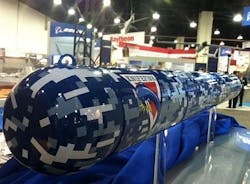Bluefin to build UUV for NRL to help Navy develop low-frequency broadband technology
QUINCY, Mass., 25 Jan. 2013. Marine scientists at the U.S. Naval Research Laboratory (NRL) in Washington needed unmanned underwater vehicles (UUVs) to help develop low-frequency broadband (LFBB) payload technology and support basic and applied research in undersea warfare. They found their solution from UUV specialist Bluefin Robotics in Quincy, Mass.
Bluefin unmanned vehicles designers will produce for NRL a variation of the Knifefish UUV, which the company is developing for the U.S. Navy Surface Mine Countermeasure Unmanned Underwater Vehicle (SMCM UUV) program for which Bluefin is under subcontract to General Dynamics Advanced Information Systems.
Bluefin completed the preliminary design review earlier this year for Knifefish -- a specialized version of the Bluefin-21 UUV -- and will capitalize on that design to deliver a UUV to NRL, Bluefin officials say.
Bluefin's technology has proven suitable for specialized acoustic payloads like NRL's LFBB sonar, company officials say. For the past 10 years, engineers from Bluefin and NRL have worked on developing and fielding the Reliant UUV, a Bluefin-21 used as a science and technology system for the original LFBB development.
"The science made possible with this vehicle will advance the nation's mine-hunting capabilities that can be incorporated into future generations of UUVs," says Dr. Brian Houston, acting head of NRL's Physical Acoustics branch.
The UUV that Bluefin is developing for NRL will have two-way Iridium satellite communications, specialized sensors, and empty sections for acoustic payloads such as a towed receiver array, and a reacquisition capability.
Bluefin also will deliver topside support equipment and graphical-user interface software tools.
For more information contact Bluefin Robotics online at www.bluefinrobotics.com, or the Naval Research Laboratory at www.nrl.navy.mil.
